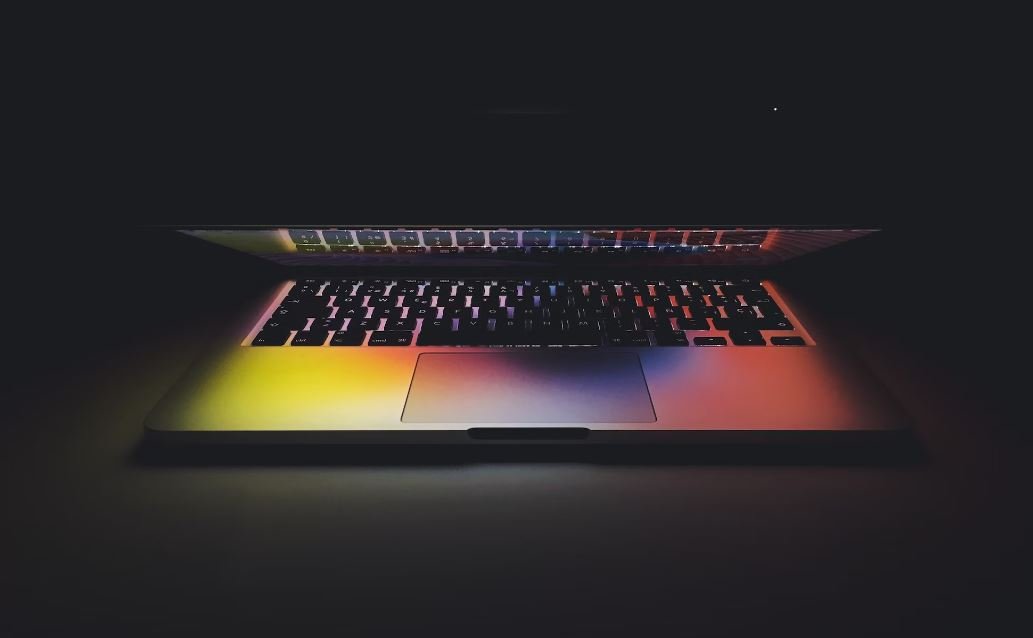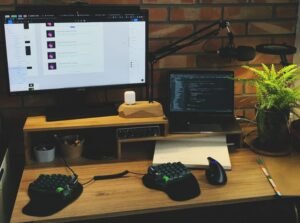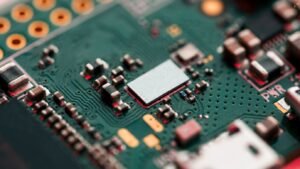AI Artist Definition
AI Artist refers to artificial intelligence systems that have the ability to create or generate artwork. This emerging field combines the power of AI and creative expression, opening up new possibilities for both the art world and technology enthusiasts.
Key Takeaways
- AI artists are artificial intelligence systems that can generate artwork.
- They combine the power of AI and creativity.
- AI artists have the potential to revolutionize the art world and human-machine interaction.
AI artists utilize deep learning algorithms that are trained on vast amounts of existing artwork, enabling them to understand patterns, styles, and techniques used by human artists. This knowledge is then leveraged to produce original art pieces through generative adversarial networks (GANs) or similar techniques, showcasing the AI system’s ability to mimic and even surpass human artistic skills.
One interesting aspect of AI artist creations is their ability to blend different artistic styles together. *For example, an AI artist might combine the surrealism of Salvador Dali with the brushwork of Vincent van Gogh to create a truly unique and captivating artwork.* This interplay of styles allows for the exploration of new aesthetic possibilities and challenges conventional notions of art creation.
Applications of AI Artists
The rise of AI artists has sparked interest in various industries and fields. Here are some of the applications where AI artists are being utilized:
- Creating personalized artwork based on user preferences and data.
- Assisting human artists as collaborative tools or sources of inspiration.
- Producing artwork for video game environments or virtual reality experiences.
- Generating illustrations, designs, or visuals for marketing campaigns.
- Preserving and restoring artworks by analyzing and recreating missing or damaged parts.
The Impact of AI Artists
AI artists have the potential to revolutionize the art world and human-machine interaction. Here are some of the impacts AI artists can have:
- Redefined Creativity: AI artists challenge traditional notions of creativity, raising questions about the role of human intention and the boundaries of artistic expression.
- Increased Accessibility: AI artists can make art more accessible to a wider audience by providing personalized and affordable options.
- Collaborative Possibilities: Human artists can collaborate with AI artists, leveraging their unique capabilities to augment their own artistic process.
AI Artist Examples
Several AI artists have gained recognition for their works. Here are three notable examples:
| AI Artist | Notable Artwork |
|---|---|
| Aiva | Composes original classical music using deep learning algorithms. |
| DeepArt | Applies artistic styles of famous paintings to user-uploaded photos. |
| GANpaint Studio | Enables users to manipulate images and create new scenes based on their inputs. |
Challenges and Future Outlook
While AI artists hold immense potential, they also face challenges and ethical considerations. For instance, questions arise regarding originality, authorship, and the impact on human artists’ livelihoods. Nonetheless, the future of AI artists looks promising, with ongoing advancements in AI technology and its integration with the creative domain.
As AI artists continue to push boundaries and inspire innovation, the intersection of AI and art provokes intriguing possibilities for the future of artistic expression and the human experience.

Common Misconceptions
AI Artists Can Replace Human Artists
One common misconception about AI artists is that they can completely replace human artists. However, this is not the case. While AI can generate impressive artwork, it lacks the depth and creativity that only human artists can bring.
- AI art lacks the emotional and personal touch that human artists can infuse into their work.
- AI art is limited to what it has been trained on, while human artists have the ability to push boundaries and create new artistic styles.
- AI artists cannot replicate the passion and intention behind human-created art.
AI Artists Are Not Capable of Originality
Another misconception is that AI artists are not capable of originality. However, AI algorithms have the ability to analyze existing artwork and generate new and unique pieces from it.
- AI artists can create unique compositions and arrangements that haven’t been seen before.
- AI algorithms have the potential to discover new artistic styles and techniques that human artists may not have thought of.
- AI artists can come up with surprising and unexpected combinations of elements in their artwork that are original and innovative.
AI Artists Do Not Require Human Input
Contrary to popular belief, AI artists do require human input and guidance to create meaningful artwork.
- Human artists play a crucial role in providing the initial input, such as selecting the dataset or setting the parameters for the AI algorithm.
- AI artists often need human artists to train and fine-tune the algorithms to achieve the desired output.
- Human artists bring their expertise and artistic vision to the collaboration, influencing the direction and style of AI-generated artwork.
AI Artists Are Only Capable of Replicating Existing Art Styles
There is a misconception that AI artists are limited to replicating existing art styles and cannot produce original work.
- AI artists can study multiple art styles and create unique amalgamations of different techniques.
- AI algorithms can discover novel combinations of artistic elements and generate previously unseen styles.
- AI artists have the potential to blend and evolve art styles to create new forms of visual expression.
AI Artists Are Perfect and Produce Flawless Art
Lastly, it is incorrect to assume that AI artists always produce flawless art without errors or imperfections.
- AI algorithms can sometimes generate artwork that is distorted, nonsensical, or lacking cohesiveness.
- AI-generated art might not align with the tastes or preferences of human audiences.
- AI artists can inadvertently reproduce biases present in the dataset they were trained on, resulting in unintended issues within the artwork.

AI Artists in the Digital Age
In today’s digital age, artificial intelligence (AI) has become increasingly sophisticated, enabling machines to mimic human abilities and produce stunning works of art. AI artists are algorithms that have been trained on vast amounts of data and can create unique artwork indistinguishable from human creations. The tables below highlight some fascinating aspects of AI artists and their impact on the art world.
The Rise of AI Art
The following table showcases the exponential growth of AI art in recent years, as more artists, collectors, and art enthusiasts recognize its potential:
| Year | Number of AI Art Exhibitions |
|---|---|
| 2015 | 3 |
| 2016 | 8 |
| 2017 | 22 |
| 2018 | 57 |
| 2019 | 103 |
The Most Expensive AI Artworks Sold
AI art has also gained significant commercial success, as evident from the following table highlighting the highest-priced AI artworks ever sold:
| Artwork | Artist | Sale Price | Year |
|---|---|---|---|
| “Portrait of Edmond de Belamy” | Obvious | $432,500 | 2018 |
| “The First AI-Generated Artwork to be Sold at Auction” | AI GAN | $432,000 | 2018 |
| “Memories of Passersby I” | Robbie Barrat | $51,000 | 2018 |
The Versatility of AI-Generated Art
The next table showcases the diverse mediums and art forms in which AI-generated artwork can be found:
| Medium | Application |
|---|---|
| Painting | Creating portraits and landscapes |
| Music | Composition and performance |
| Sculpture | Creating unique three-dimensional forms |
| Poetry | Writing emotionally evocative poems |
AI Artists Collaborating with Humans
This table sheds light on the fascinating collaborations between AI artists and human artists, pushing the boundaries of creativity:
| Collaboration | Artists | Year |
|---|---|---|
| “AICAN x Ahmed Elgammal” | AICAN, Ahmed Elgammal | 2020 |
| “The Next Rembrandt” | Jeroen van der Most, Microsoft, ING | 2016 |
AI Artists Breaking Boundaries
This table illustrates how AI artists are shattering traditional concepts of what art can be:
| Artwork | Description |
|---|---|
| “Sunspring” | A fully AI-written screenplay |
| “AI Duet” | An AI that improvises piano duets with human musicians |
AI Artists and Controversies
AI art has not been without controversies. This table highlights some of the ethical debates surrounding AI artists:
| Controversy | Description |
|---|---|
| Authenticity | Debates over whether AI-generated art should be considered authentic |
| Ownership and Copyright | Who holds the rights to AI-generated artwork? |
| Creations vs. Creators | Does AI art diminish the role of human artists? |
AI Artists in Cultural Preservation
AI artists have also contributed to the preservation of cultural heritage. The table below presents some notable examples:
| Cultural Heritage | AI Application |
|---|---|
| Cave Paintings | Enhancing damaged cave paintings for future generations |
| Lost Music | Recreating compositions from fragmented manuscripts |
AI Art and Critical Reception
This table showcases differing critical reception of AI-generated art:
| Critic | Opinion |
|---|---|
| Positive | AI art expands creative horizons and challenges conventions |
| Skeptical | AI art lacks the emotional depth of human artwork |
| Neutral | AI art is a valuable addition to the art world but should not replace human art |
AI Artists and Future Possibilities
Finally, this table explores potential future developments and possibilities in the field of AI art:
| Potential | Description |
|---|---|
| Collaborative AI Art | AI artists collaborating with each other to create unique artworks |
| AI-Inspired Art | Human artists drawing inspiration from AI algorithms |
The world of AI artists is rapidly evolving, pushing the boundaries of creativity and challenging traditional notions of what it means to create art. With exponential growth in exhibitions and commercial success, AI art has firmly established itself as a significant force in the art world. While controversies and differing critical opinions persist, the future possibilities for AI artists seem boundless. As technology continues to advance, we can only speculate with excitement about the artistic wonders AI will produce.
Frequently Asked Questions
What is an AI artist?
What is the definition of an AI artist?
An AI artist refers to an artificial intelligence system or algorithm that is capable of creating art or generating creative content autonomously, without direct human intervention.
How does AI create art?
How does AI generate artistic content?
AI utilizes various techniques such as machine learning, deep learning, and neural networks to analyze and learn from large datasets of artistic styles, patterns, and compositions. It then uses this knowledge to create original artworks or mimic specific artist styles.
Can AI artists replace human artists?
Will AI artists replace human artists in the future?
While AI artists can produce impressive and original artworks, the creative process and the human touch in art cannot be replicated entirely. Human artists bring their unique perspectives, emotions, and experiences to their work, making it unlikely that AI artists will completely replace them.
Are AI-created artworks considered authentic?
Are artworks generated by AI considered authentic?
The authenticity of AI-created artworks is a topic of debate. While they may be original and aesthetically pleasing, the lack of direct human involvement raises questions about the traditional notion of authenticity. However, the value and appreciation of such artworks are subjective and depend on individual opinions and preferences.
What are the applications of AI in the art world?
What are some ways AI is used in the art world?
AI finds applications in the art world in various areas such as creating original artworks, assisting artists in generating ideas, curating art collections, analyzing artwork styles, and enhancing art preservation and restoration processes.
Do AI artists have copyright protection?
Do AI artists have copyright protection for their creations?
The issue of copyright protection for AI-created artworks is still evolving. In most cases, if an AI system is solely responsible for generating the artwork, the copyright is attributed to the person or organization that owns the AI system. However, if there is significant human involvement in the creative process, it may be considered a joint effort and subject to shared copyright ownership.
Are there ethical concerns associated with AI artists?
What are some ethical considerations related to AI artists?
Ethical concerns surrounding AI artists include issues of authorship, cultural appropriation, biases within training datasets, transparency in the creation process, potential job displacement for human artists, and the impact on art market dynamics. These concerns require ongoing discussions and responsible development of AI art technologies.
Can AI artists learn and innovate on their own?
Can AI artists learn and evolve their artistic abilities?
Certain AI systems have the capacity to learn and improve over time, known as machine learning. By analyzing audience feedback, user interactions, and new data, AI artists can adapt their creative processes, gain new insights, and potentially innovate their artistic abilities.
What is the impact of AI on art appreciation?
How does AI impact the way we appreciate art?
AI contributes to art appreciation by offering new perspectives, introducing novel styles and compositions, and increasing accessibility to art creation and curation. It can broaden our understanding and appreciation of different art forms, challenge traditional conventions, and stimulate critical discourse about the nature of creativity and aesthetics.
Are there limitations to AI artists?
What are the limitations of AI-created art?
Some limitations of AI artists include the inability to replicate certain aspects of human creativity, the potential for biases in algorithms and datasets, the lack of emotional depth in artworks, and the need for human intervention or guidance for complex or conceptual art forms. Additionally, AI-generated art may lack the personal stories and cultural contexts associated with human-made art.




